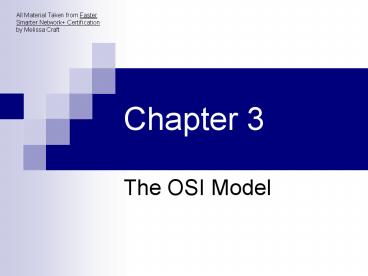The OSI Model PowerPoint PPT Presentation
1 / 18
Title: The OSI Model
1
Chapter 3
All Material Taken from Faster Smarter Network
Certification by Melissa Craft
- The OSI Model
2
The OSI Model is often referred to as a Protocol
Stack
3
The Layers
- The Upper layers (Application, Presentation, and
Session) facilitate moving data between
applications. - The Middle Layers (Transport, Network) handle
movement between network segments. - The Lower Levels (Data-link, Physical) deal with
physical and logical topology and enable movement
across a single network segment.
4
Encapsulation
- The sending computer passes data down in the
stack (encapsulation). - Each layer breaks the message down into smaller
packets. - When the message reaches the physical layer, it
is converted into signals and sent across the
media.
5
Encapsulation (cont)
- The message is received by the destination
computer and the message is sent upwards through
the stack - Each layer reassembles the message into larger
packets - Data is fully assembled at the application layer.
6
The Physical Layer
- Transmits raw data in streams of bits across
physical media - Uses electrical impulses, light signals, or radio
signals - Connections are either multipoint or
point-to-point - Repeaters and hubs operate at this level
7
The Data-Link Layer
- Supplies hardware addresses, identifies errors,
and provides flow control - Assembles bits from physical layer into frames
- Ethernet, token Ring, and ATM are Data-Link
protocols - Switches and Bridges operate at this level.
8
The Data-Link Layer (cont.)
- Media Access Control (MAC)
- Contention-who gets to transmit?
- Polling-are you ready to transmit? (rarely used)
- Token passing-A special frame called the Token is
passed around the ring. A device must have the
token in order to transmit.
9
The Data-Link Layer (cont.)
- MAC addresses
- Assigned to every NIC by the manufacturer
- Addresses are 6 bytes in length
- First 3 bytes identify manufacturer
- Hexadecimal digits (numbers 0-9, letters A-F)
- Address appears in Data-Link frame header
10
The Data-Link Layer (cont.)
- Logical Link Control
- Uses control packets called Protocol Data Units
(PDUs) which contain header information for
network layer - Can be used in connectionless or
connection-oriented services - Provides flow control and frame sequencing
11
The Network Layer
- Provides internetworking services (different
network segments) - Determines best route to send data if multiple
routes exist - Error handling, congestion control, packet
sequencing - Datagrams are converted into frames when passed
onto the data-link layer - Routers operate at this level
12
The Network Layer (cont.)
- Cell switching
- Circuit Switching
- Message Switching
- Packet Switching
- (See Pages 79-82)
13
The Transport Layer
- Provides for transparent transfer between sender
receiver - Ensures that data is completely transferred
- Uses port numbers
- Multiplexing is made possible here
- Can be connectionless or connection oriented
- Uses ACK (acknowledgement) or NAK (negative
acknowledgement) packets to verify data delivery
if a connection-oriented mode is used
14
The Session Layer
- Establishes connection between applications and
manages the connection until termination - Remote procedure calls (RPCs) function here. This
is when a remote computer executes a program and
it appears that it is running on the remote
computer (Citrix and Telnet) - Ensure proper termination and reallocation of
resource afterwards - Sets agreement services used duration of
services - Verification of IDs passwords occur here
15
The Session Layer (cont.)
- Data is transmitted one of 3 ways in a session
- Simplex-data can travel only in one direction
(am/fm radio or television) - Half-duplex-data can travel both ways, but only
one way at a time (walkie-talkies CB radios) - Full-duplex-simultaneous communication in both
directions (telephone)
16
The Presentation Layer
- Provides way for data to be presented at the
application layer - Encryption/decryption
- Data compression/expansion
- Also know as syntax layer
17
The Application Layer
- Supports end-user processes
- Typically the only layer involving end-user
interaction - Identifies sending receiving devices, quality
of service (QoS) authentication privacy - File transfers, E-mail, Web browsing, chat,
network printing all happen here.
18
Network Equipment and OSI Layers
- NICS operate at Layers 1 and 2.
- Hubs and repeaters operate at Layer 1.
- Bridges and Switches operate at layer 2.
- Routers operate at Layer 3
- Brouters operate at both layers 2 and 3.
- Gateways operate at Layers 5, 6, and 7.

